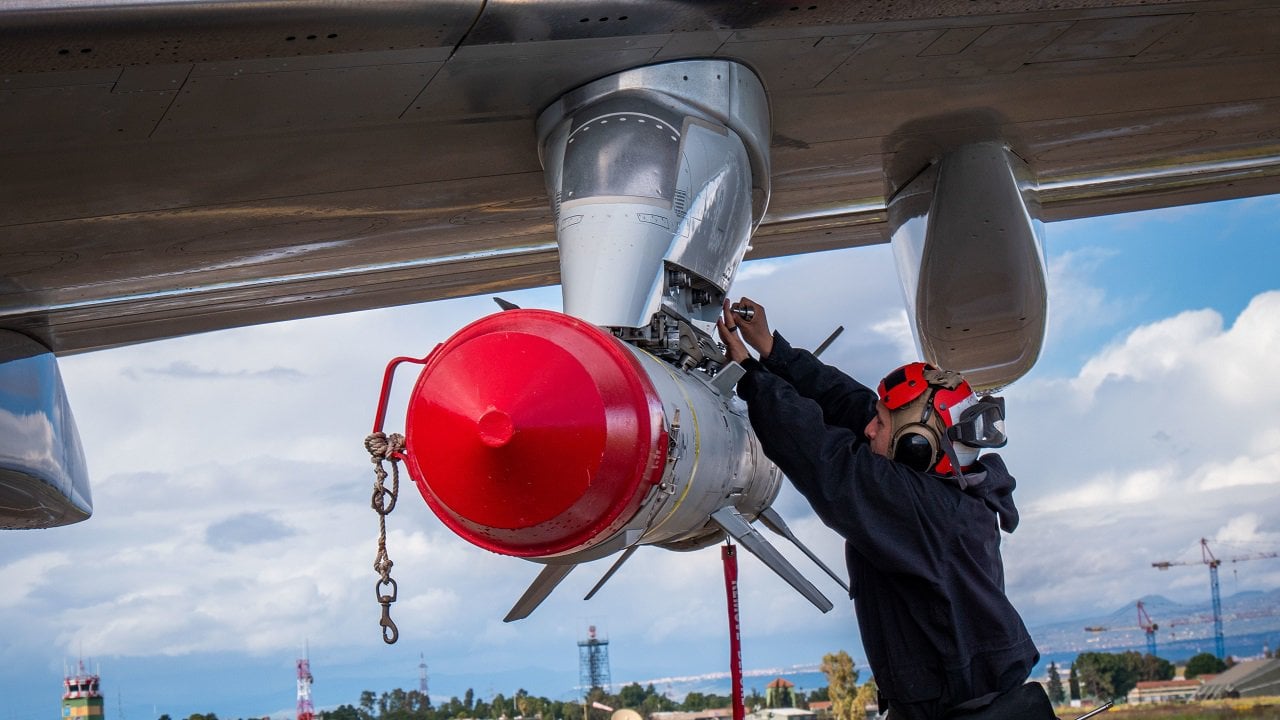It looks like death by Harpoon for Russia – A video shared by the Ukrainian military suggests that Russia’s war in Ukraine has resulted in yet another vessel meeting its doom in the contested waters of the Black Sea.
The video is seemingly recorded by an overflying Bayraktar drone judging by its distinctive user interface. In the distance, a ship the Ukrainian military claims to be the Russian Project 22870 rescue tug Vasily Bekh, can be seen being struck by two seas-skimming anti-ship missiles in succession, causing the vessel to erupt in a ball of obscuring flame. The vessel is believed to have been located about 20 miles east of Snake (or Zmiinyi) island, infamously shelled and captured by Russian forces in February.
As the missiles approach from a completely different vector than the recording drone, it’s highly unlikely the Bayraktar is the source of the attack. This was not the case with earlier strikes on four Raptor-class patrol boats and a Serna-class landing craft near Snake Island, which were evidently struck by smaller MAM-L laser-guided anti-tank missiles fired by a Bayraktar.
Instead, the vessel’s destruction appears likely to be the work of Ukraine’s truck-mounted anti-ship missile batteries, which may have received targeting data from the Bayraktar. Ukraine managed to rush some of its indigenous Neptune coastal defense missiles into service which fatally damaged the Russian missile cruiser Moskva.
But Odesa’s regional governor claimed on social media the attack was executed by Harpoon missile batteries recently delivered to Ukraine, which were reported to be operationally deployed on June 9.
Indeed, Ukraine is currently receiving Harpoon missiles and launchers from the United States, Denmark, The Netherlands, and the United Kingdom. The Danish RGM-84L-4 Harpoon missiles are known to have a range of 77 miles, are hardened with various electronic-counter measures, and combine both GPS and inertial guidance while approaching the target area.
The Vasily Bekh’s destruction has yet to be confirmed, with some Russian sources claiming the Bekh had 32 crew onboard at the time of the attack, with 11 now missing (presumably dead) and the rest injured.
The 1,200-ton rescue tug is considerably larger than the harbor tugs we more commonly see in ports. They’re meant to help recover damaged ships at sea, and indeed the Vasily Bekh was loaded with firefighting gear and submersible rescue vessels. However, Ukraine claims Bekh was on a delivery run laden with munitions, supplies, and missiles for delivery to Russia’s Snake Island garrison—including a Tor-M2KM short-range air defense system visible on her deck.
Ship vs. Fort, 21st Century Style Thanks to Harpoon
British Admiral Horatio Nelson is often quoted as saying “A ship’s a fool to fight a fort.” It was not just a clever turn of phrase: in a match between 19th-century warships and equivalent firepower in terms of fortified coastal guns, the side most likely to win was the one that couldn’t sink.
Of course, technologies have changed quite a bit two centuries later, and now both the ship and the proverbial land-based fort can strike targets dozens or even hundreds of miles away with cruise missiles—missiles with heavy warheads powerful enough to make physical fortification of limited value. Instead, both the warship and its land-based foes—more likely to be highly mobile trucks, though launchers in fortified siloes do still exist—depend on mobility, stealth, and air defenses to survive.
#Ukraine: Big news from the Black Sea- the Ukrainian Navy claims to have destroyed the Russian “Vasily Bekh” rescue vessel, as it travelled to the famous Snake Island; it reportedly had a Tor-M2KM SAM system on board.
The strike was filmed by a TB-2 drone; 2 munitions are used. pic.twitter.com/pCjMf2RX4d
— ?? Ukraine Weapons Tracker (@UAWeapons) June 17, 2022
Furthermore, as illustrated in the case of the unhappy Vasily Bekh, the ‘fort’ can now go after distant ships that have no intention of directly engaging coastal defenses.
In the battle pitting ships against missile-toting trucks, the latter has two clear advantages. The first is that a truck on land has far more options for concealment than a ship at sea, posing a real needle-in-the-haystack challenge to locate and attack. Second, losing an individual missile-launching truck is not nearly as big a deal as sinking or even heavily damaging a warship.
Modern warships, to be fair, tend to bristle with different types of sophisticated air defense missiles and electronic countermeasures to protect against missile attacks. But the scant available datapoints for post-World War II naval warfare, notably including the 1982-era Falkland War, seem weighted in favor of cruise missiles penetrating those defenses.
The other problem for land-based batteries is that they likely depend on a separate spotter to detect distant ships and provide them with targeting data. Thus, if you have the means to blind or destroy the spotters, than battery’s firepower is greatly reduced in reach.
In this latest incident, Ukraine likely benefited from the surveillance capabilities of the drone recording the attack, but it may also have received targeting data from U.S. reconnaissance assets which Russia can’t attack without repercussions.
The ship-vs-fort war should be of particular interest to both China and Taiwan, which both have invested in huge arsenals of land-based anti-ship missiles. The surprising successes of Ukraine’s smaller anti-ship batteries against Russia’s Black Sea Fleet bode ill for China’s contingency plans for a massive amphibious landing force to assault Taiwan’s massed anti-ship defenses. But the reverse also holds true: China’s capability to strike U.S. warships coming to Taiwan’s aid from afar might be greater than formerly estimated.
Sébastien Roblin writes on the technical, historical, and political aspects of international security and conflict for publications including The National Interest, NBC News, Forbes.com, War is Boring, and 19FortyFive, where he is Defense-in-Depth editor. He holds a Master’s degree from Georgetown University and served with the Peace Corps in China. You can follow his articles on Twitter.

